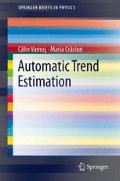Abstract
In this chapter we design a numerical algorithm to generate nonmonotonic trends with a diversity of shapes comparable to those encountered in practice. This original algorithm is essential for all the rest of the book because it provides the numerical trends on which the estimation methods are tested. Over these trends finite AR(1) noises are superposed so that the resulting artificial time series depend on five independent parameters. In the case of the trend estimation algorithms the complexity of the problem is reduced because the accuracy of the estimated trend significantly depends only on three parameters: the time series length, the noise serial correlation, and the ratio between the amplitudes of the trend variations and noise fluctuations. Using Monte Carlo experiments we derive the accuracy of a simple method to estimate the serial correlation of an AR(1) noise.
Access this chapter
Tax calculation will be finalised at checkout
Purchases are for personal use only
References
Box, G., Jenkins, G., Reinsel, G.: Time Series Analysis: Forecasting and Control, 3rd edn. Prentice-Hall, Upper Saddle River (1994)
Box, G.E.P., Pierce, D.A.: Distribution of the autocorrelations in autoregressive moving average time series models. J. Am. Stat. Assoc. 65, 1509–1526 (1970)
Brockwell, P.J., Davies, R.A.: Time Series: Theory and Methods, 2nd edn. Springer, New York (1996)
Fornberg, B.: A Practical Guide to Pseudospectral Methods. Cambridge University Press, Cambridge (1998)
Hamilton, J.D.: Time Series Analysis. Princeton University Press, Princeton (1994)
Hirsch, R.M., Slack, J.R.: A nonparametric trend test for seasonal data with serial dependence. Water Resour. Res. 20, 727 (1984)
Kendall, M.G.: Rank Correlation Methods. Griffin, London (1975)
Marsaglia, G., Tsang, W., Wang, J.: Evaluating kolmogorov’s distribution. J. Stat. Softw. 8(18), 1–4 (2003)
Metropolis, N., Ulam, S.: The monte carlo method. J. Am. Stat. Assoc. 44, 335–341 (1949)
Press, W.H., Teukolsky, S.A., Vetterling, W.T., Flannery, B.P.: Numerical Recipes in C. The Art of Scientific Computing, 2nd edn. Cambridge University Press, Cambridge (1992)
Vamoş, C., Crăciun, M.: Serial correlation of detrended time series. Phys. Rev. E 78, 036707 (2008)
Author information
Authors and Affiliations
Corresponding author
Rights and permissions
Copyright information
© 2012 The Author(s)
About this chapter
Cite this chapter
Vamos, C., Craciun, M. (2012). Monte Carlo Experiments. In: Automatic trend estimation. SpringerBriefs in Physics. Springer, Dordrecht. https://doi.org/10.1007/978-94-007-4825-5_2
Download citation
DOI: https://doi.org/10.1007/978-94-007-4825-5_2
Published:
Publisher Name: Springer, Dordrecht
Print ISBN: 978-94-007-4824-8
Online ISBN: 978-94-007-4825-5
eBook Packages: Physics and AstronomyPhysics and Astronomy (R0)

